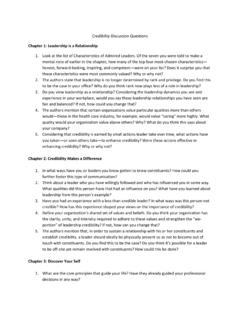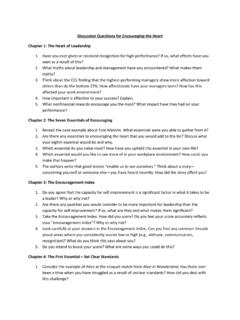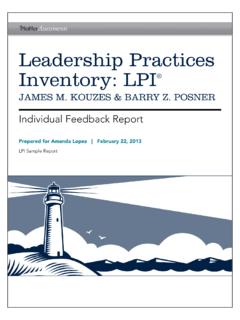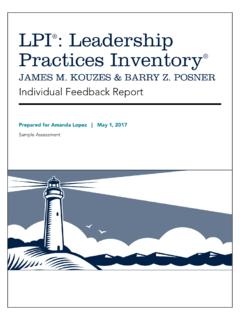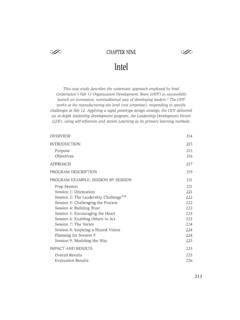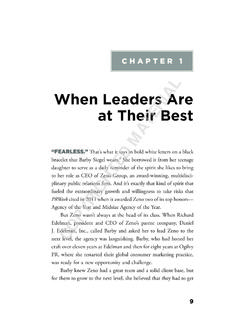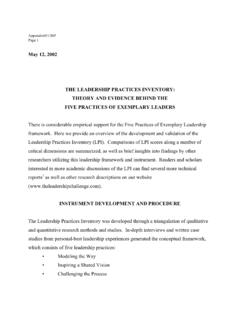Transcription of CHAPTER 1. WHEN LEADERS ARE AT THEIR BEST
1 THE LEADERSHIP CHALLENGE, 5TH EDITION. discussion QUESTIONS. Below are examples of questions that you can pose to the whole group or give to small groups for discussion . Some of these questions could also be given to individuals or teams as assignments. CHAPTER 1. WHEN LEADERS ARE AT THEIR BEST. What does leadership mean to you? What is the difference, if any, between management and leadership? What are some of the key behaviors and actions you took whenever you've been at your own best as a leader? Describe the key actions and behaviors of the person that you've experienced as your best leader? Are LEADERS born or made? What is the meaning of the statement Leadership is a relationship ? Why is credibility the foundation of leadership ? Explain what DWYSYWD stands for. Why is it important? What does it have to do with leadership?
2 PRACTICE 1. MODEL THE WAY. What is a role model ? In what ways are role models important for LEADERS ? Who are your role models? THEIR characteristics? What have you learned from them? Have they always been positive? In what ways does having more clarity about your values help you become a better leader? What is the difference between being deeply committed to a value and imposing your will on others? Why does a leader need to know the difference? What does find your voice mean in terms of leadership? Give examples. In what ways do individuals and organizations benefit from shared values? discussion Questions, p. 1. Think of a time that you or a leader you know successfully Modeled the Way. Describe what happened. What are common obstacles to Modeling the Way? Which kinds of obstacles are valid and which can be overcome?
3 Give examples. If students complete the LPI: Which of the leadership behaviors associated with Model the Way are the most difficult for you to engage in and why? What does it take to meet this challenge? PRACTICE 2. INSPIRE A SHARED VISION. When people take the LPI, Inspire a Shared Vision consistently receives the lowest average score among the Five Practices. What are some of the reasons that this is generally the most uncomfortable leadership practice? What does being forward-looking mean? Why is it an important characteristic for a leader? Give examples of what it means to be forward-looking. What actions can LEADERS take to envision the future? What can LEADERS do to help others in the organization see the future? What are some examples of how leader can communicate a vision so that others will share it? What is a vision?
4 What is the relationship of a vision to a mission statement? How can LEADERS make sure that they know what the hopes, dreams, and aspirations of THEIR constituents are? Think of a time that you or a leader you know Inspired a Shared Vision. Describe what happened. What are common obstacles to Inspiring a Shared Vision? Which kinds of obstacles are valid and which can be overcome? Give examples. If students complete the LPI: Which of the leadership behaviors connected with Inspire a Shared Vision is most difficult for you to engage in and why? What does it take to meet this challenge? discussion Questions, p. 2. PRACTICE 3. CHALLENGE THE PROCESS. Think of a time that you or a leader you know Challenged the Process. Describe what happened. What are some of the actions a leader can take to create a climate for change and encourage risk-taking?
5 Be specific. What makes the challenge meaningful for those who push THEIR own limits to get extraordinary things done, who risk THEIR security to change the social condition or risk THEIR lives to save others or defend liberty? In general, what makes something new and innovative worthwhile doing? In your own personal-best story and those you heard in your discussion group, what made the challenges meaningful? What does it mean to exercise outsight ? Why is it important? Give examples of the ways in which outsight can help LEADERS challenge the process successfully. What are small wins ? Why are they important? Give examples of small wins. Why is learning from experience important? Describe a time when you have learned from experimentation and even failure. What did you learn that you might not have learned if you hadn't had that experience?
6 Should LEADERS let THEIR constituents fail? Explain your answer. What is resilience? How can resilience be developed and promoted? What are common obstacles to Challenging the Process? Which kinds of obstacles are valid and which can be overcome? Give examples. If students complete the LPI: Which of the leadership behaviors connected with Challenge the Process is most difficult for you to engage in and why? What does it take to meet this challenge? PRACTICE 4. ENABLE OTHERS TO ACT. Think of a time when you felt powerful and a time when you felt powerless as a result of what someone said or did. Describe specifically what the person said or did in each situation. What was the effect on your emotional state? Your morale? Your performance? Summarize the implications for LEADERS of making people feel powerful or powerless.
7 discussion Questions, p. 3. Explain the implications for LEADERS of the statement We become most powerful when we give our own power away. Give a few examples. How can LEADERS create a climate of trust and facilitate relationships among people in a work team? What can LEADERS do to show others that they are trustworthy? What can they do to demonstrate that they trust others? What are some ways in which LEADERS can give other people more control of THEIR work? What are some ways in which LEADERS can get people interacting? What are some steps LEADERS can take to develop people's competencies and foster THEIR confidence? Do you think that everyone wants to develop themselves? Indeed, does everyone want to be a leader? What do your responses mean for LEADERS and leadership development? Think of a time that you or a leader you know enabled someone to act.
8 Describe what happened. What are common obstacles to Enabling Others to Act? Which kinds of obstacles are valid and which can be overcome? Give examples. If students complete the LPI: Which leadership behaviors in the Enable Others to Act leadership practice are most difficult for you to engage in and why? What does it take to meet this challenge? PRACTICE 5. ENCOURAGE THE HEART. Think of a time that you or a leader you know Encouraged the Heart. Describe what happened. How are goals, expectations, and standards connected with one another? How are they connected to Encourage the Heart? What's the purpose of feedback? Why is it important for LEADERS to focus on clear standards and provide feedback? Give examples from your own experiences. What does the advice to LEADERS to be personally involved mean? Why is being personally involved important?
9 What are some ways in which a leader can get personally involved and show that he or she cares? What is the most meaningful recognition you have ever received? Be specific about the way in which you were recognized. What made this recognition meaningful? discussion Questions, p. 4. What are some creative and imaginative ways in which you can recognize the contribution of an individual? Celebrate the accomplishments of a group? What are some ways in which community, celebration, and commitment are connected? What are the implications for LEADERS ? What are common obstacles to Encouraging the Heart? Which kinds of obstacles are valid and which can be overcome? Give examples. If students complete the LPI: Which of the leadership behaviors associated with Encouraging the Heart is most difficult for you to engage in and why?
10 What does it take to meet this challenge? CHAPTER 12. LEADERSHIP IS EVERYONE'S BUSINESS. What is meant by the statement leadership is everyone's business ? Can this not be true? What are three things that can be done to improve in each leadership practice? What are some applications of these to your own leadership development? What are three things that you can do to continue learning to be a better leader? What are some specific ways you can apply them to your own leadership development? How is it that leadership is an affair of the heart? discussion Questions, p. 5.
